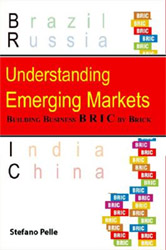Dec 10, 2025
Dec 10, 2025
Book: "Building Business BRIC by Brick"; Author: Stefano Pelle;
Publisher: Sage Publications; Price: Rs.295

Pelle, vice-president and chief operating officer (business unit Russia and South Asia) of the Italian confectioner Perfetti Van Melle group and chairperson of Perfetti Van Melle India, has been living in South Asia since 1998 and is a keen watcher of at least three BRIC countries at close quarters.
Before joining the Perfetti Van Melle group, he headed a division of the Italian State Railways and was made 'Knight Commander' by the Italian president in 2006.
If anyone can comment on the four great soaring economies of the world, perhaps Pelle can. He has a word of caution for existing big brothers in business: the buoyancy of the emerging economies drastically alters the global geopolitical situation by increasing the weight of the rising nations that become a stronger counterpart to the current US dominance.
The trends and shifts are already in operation, he says, explaining what an "emerging market" is and noting that over 50 percent of the world's population lives in the BRIC countries.
"China has joined the WTO (World Trade Organization), causing a major change in the trade flow. The fall of communism has provided an opportunity for a radical shift to open the market model for Russia and surrounding republics. The NAFTA (North American Free Trade Agreement) as well as gradual control of inflation has helped South American countries grow," he said at the launch of his book in Chennai.
"The spread of English as an international language and the communication and information revolution brought by the most recent technological innovation have completed the scenario," Pelle added.
Local talent and cultural intelligence play a big role in emerging markets, the author says. In India, there is a great amount of local talent and skill but also bureaucracy. Brazilians value loyalty - confrontation is not part of their temperament. In Russia, there are lingering traces of racism that surface, particularly at the workplace. China, Korea and Taiwan score on the shop floor and in manufacturing, he says.
China is the emerging superpower, Pelle asserts, warning that the 21st century phenomena could be reverse colonialism. As evidence, he provides enough growth charts and examples of businesses going wrong. Interestingly, the book also contains media excerpts indicative of the trends.
The book is sure to make an interesting read not only for only students of business and economics, but also for historians, policy makers and politicians.
The royalty from this book goes to NGOs taking care of underprivileged children in India.
23-Feb-2007
More by : Papri Sri Raman